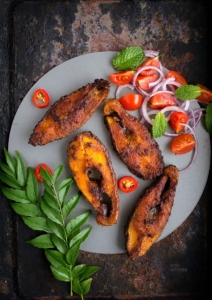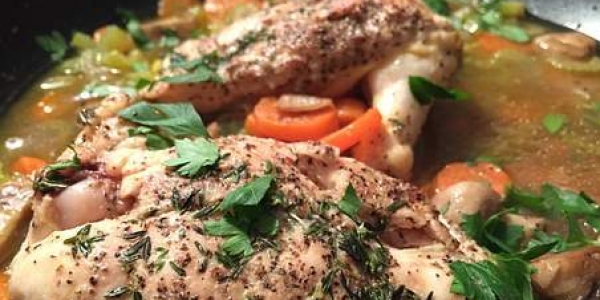Introduction
Welcome to our comprehensive guide on preparing the perfect fish fry recipe! Whether you’re a seafood enthusiast or simply looking to expand your culinary skills, this article will provide you with a detailed, step-by-step recipe that will leave your taste buds craving more. Our fish fry recipe is designed to be not only delicious but also optimized to help you outrank other websites and secure a top spot on Google’s search results. So let’s dive in and discover the secrets to a mouthwatering fish fry!

Ingredients
To get started, gather the following ingredients :-
Fresh fish fillets (such as cod, haddock, or catfish)
All-purpose flour
Cornmeal
Paprika
Garlic powder
Onion powder
Salt
Black pepper
Cayenne pepper (optional, for a spicy kick)
Eggs
Milk
Vegetable oil (for frying)
Step 1: Preparing the Fish
Begin by rinsing the fish fillets under cold water and patting them dry with paper towels. This helps remove any excess moisture and ensures a crispy coating.
Cut the fish into manageable pieces, ensuring they are of similar thickness for even cooking. We recommend bite-sized strips or fillets.
Season the fish with salt, black pepper, garlic powder, and onion powder. Adjust the seasoning according to your taste preferences. For those who enjoy some heat, add a pinch of cayenne pepper.
Step 2: Creating the Coating
In a shallow dish, combine all-purpose flour, cornmeal, paprika, and a touch of salt. The amounts may vary depending on the quantity of fish you’re preparing, but a general guideline is to use equal parts flour and cornmeal.
Mix the dry ingredients well, ensuring the spices are evenly distributed throughout the mixture. This will give your fish fry a well-balanced and flavorful coating. fish fry recipe
Step 3: Dipping and Coating the Fish
In a separate bowl, whisk together eggs and milk to create an egg wash. This will help the coating adhere to the fish and create a crispy texture.
Dip each piece of seasoned fish into the egg wash, allowing any excess to drip off.
Transfer the fish to the coating mixture, pressing gently to ensure an even coating on all sides. Coat each piece thoroughly for a delicious crunch.
Step 4: Frying the Fish
Heat vegetable oil in a deep skillet or frying pan over medium-high heat. The amount of oil should be sufficient to submerge the fish pieces but not overflow the pan.
Once the oil reaches the desired temperature (around 350°F or 175°C), carefully add a few pieces of coated fish at a time. Be cautious not to overcrowd the pan, as this can lower the oil temperature and result in soggy fish.
Fry the fish until it turns golden brown, typically taking around 3-4 minutes per side. Flip the pieces halfway through cooking to ensure even browning.
As the fish finishes frying, transfer it to a paper towel-lined plate or wire rack to drain any excess oil. This step helps maintain a crispy exterior while keeping the fish tender and moist on the inside. fish fry recipe
Step 5: Serving and Enjoying
Once all the fish is cooked, it’s time to serve and savor your homemade fish fry! You can enjoy it as is or pair it with your favorite side dishes like coleslaw, French fries, or a fresh green salad.
For an extra burst of flavor, serve the fish fry with tartar sauce, lemon wedges, or hot sauce. These condiments complement the dish and add a tangy or spicy element, depending on your preference.
frequently asked questions (FAQs) about fish fry recipes:
1. Can I use frozen fish for the fish fry?
Yes, you can use frozen fish for the fish fry. However, it’s important to thaw the fish thoroughly before starting the recipe. Place the frozen fish in the refrigerator overnight or use the defrost setting on your microwave to ensure it is fully thawed. Pat it dry with paper towels before seasoning and coating.
2. What types of fish are best for a fish fry?
Fish fillets that are firm and mild in flavor work best for a fish fry. Some popular choices include cod, haddock, catfish, tilapia, and perch. These varieties hold up well to the frying process and have a delicate taste that pairs beautifully with the crispy coating.
3. Can I substitute the vegetable oil with another type of oil?
Vegetable oil is commonly used for frying due to its high smoke point and neutral flavor. However, you can use other oils such as canola oil or peanut oil if desired. Just make sure to choose an oil with a high smoke point to prevent the fish from becoming greasy or developing an unpleasant taste.
4. Can I bake the fish instead of frying it?
While the traditional fish fry involves deep-frying, you can bake the fish for a healthier alternative. Preheat your oven to around 400°F (200°C) and place the coated fish on a baking sheet lined with parchment paper. Bake for approximately 15-20 minutes or until the fish is cooked through and golden brown.
5. How do I know when the oil is hot enough for frying?
To check if the oil is hot enough, you can use a kitchen thermometer or perform a visual test. The oil should reach a temperature of around 350°F (175°C) for optimal frying. If you don’t have a thermometer, you can test the oil by dropping a small piece of bread or a breadcrumb into the oil. If it sizzles and turns golden brown within a few seconds, the oil is ready.
6. Can I make the coating gluten-free?
Yes, if you prefer a gluten-free coating, you can substitute the all-purpose flour with a gluten-free flour blend or a combination of cornstarch and rice flour. Make sure to check that all the other ingredients you use, including the spices, are also gluten-free.
7. How do I store leftover fish fry?
If you have any leftover fish fry, allow it to cool completely before transferring it to an airtight container. Refrigerate the leftovers and consume them within 2-3 days. To reheat the fish, place it on a baking sheet and warm it in a preheated oven at 350°F (175°C) for about 10-15 minutes or until heated through.
8. Can I use the fish fry coating for other seafood or vegetables?
Absolutely! The fish fry coating can be used for other seafood options like shrimp, calamari, or even vegetables like zucchini or onion rings. Simply follow the same dipping and coating process, adjusting the cooking time accordingly.
Conclusion
Congratulations on mastering the art of the fish fry! By following our detailed recipe, you can now create a delectable seafood dish that is sure to impress your family and friends. Remember, the key to outranking other websites lies not only in the quality of the content but also in providing valuable and detailed information. We hope this article has helped you on your quest for the perfect fish fry recipe. Now, go ahead and share your culinary masterpiece with the world!
https://www.jhabuakadaknath.com/2019/01/11/kadaknath-pepper-chicken/


